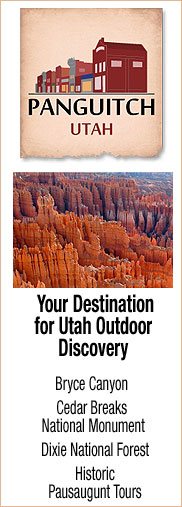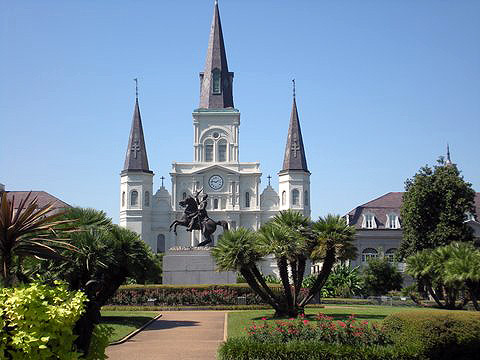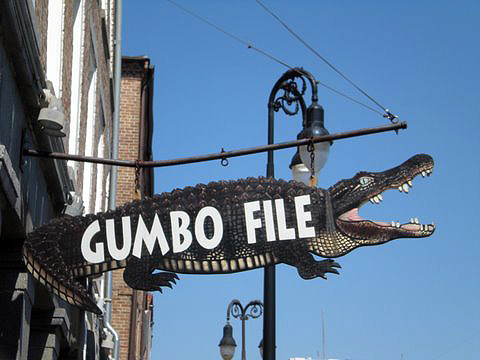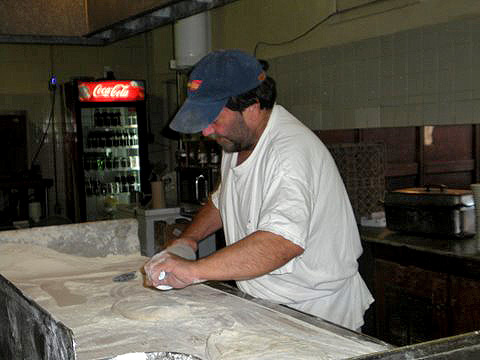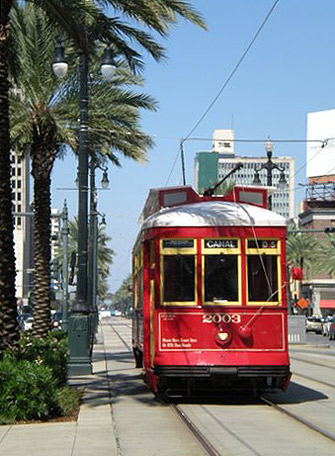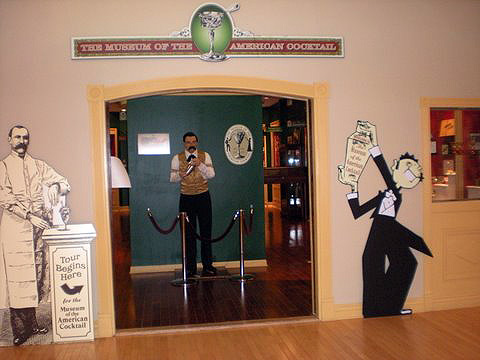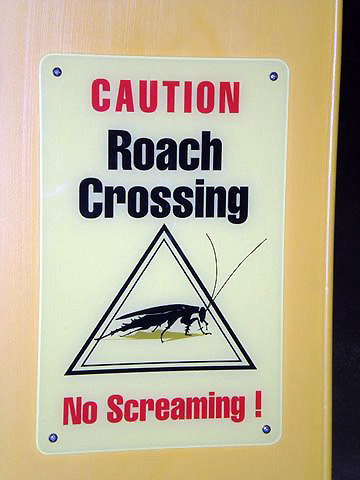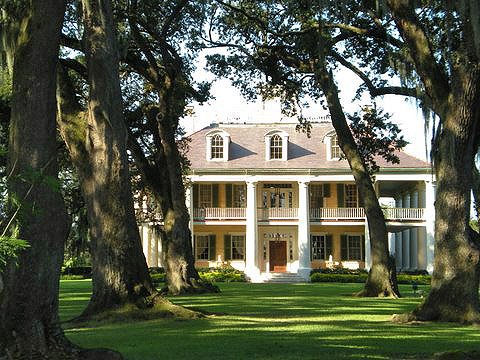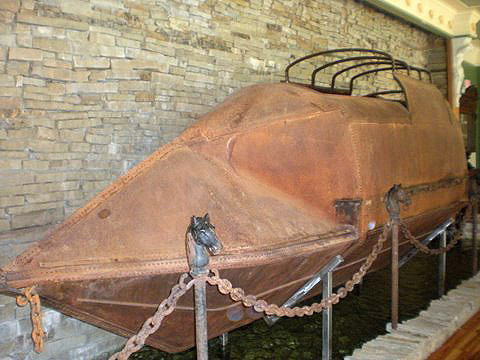 |
 |
|
 |

|
NOLA:
New Orleans, Louisiana
Story and Photos by Corinna Lothar
Named for Philippe II, Duc d’Orleans, who was regent of France during the childhood of Louis XV, New Orleans was founded on a crescent shaped bend in the Mississippi River at the beginning of the 18th century. In the beginning, the city was a settlement of wooden shacks, inhabited by rough and tough men. To accommodate the ruffians, many of whom were ex-convicts, France sent prostitutes and female prison inmates to join the male settlers. Later “casket girls” came from Paris, each selected for housewifely skills and given a small chest of things she would need to start her new life. The Ursuline Sisters founded a convent in the new city in 1727 and wayward girls were shipped to the convent. In Puccini’s opera, “Manon Lescaut,” the heroine is deported from Paris to Louisiana as a loose woman. She dies in the “desert” near New Orleans.
King Louis XV ceded much of Louisiana to his Spanish cousin, Carlos II, partly to avoid having it fall into British hands at the end of the Seven Years’ War, also known as the French and Indian War. After three quarters of the city burned in 1788 and in 1794, the city was rebuilt in Spanish style of bricks, firewalls, iron balconies and courtyards, replacing the simple wooden French buildings. The city was returned to French rule in 1800 at a time when about half of the 8,000 inhabitants were Creoles of French descent and about a quarter were Spanish. Thomas Jefferson purchased the Louisiana tract, which extended north from the Gulf of Mexico to Canada and west from the Mississippi River to the Rockies, from Napoleon in 1803 for fifteen million dollars. The Haitian rebellion against France of 1804 brought an influx of Haitians to New Orleans, bringing with them their traditions. After Andrew Jackson, with the aid of pirate Jean Lafitte, defeated the British in the Battle of New Orleans at the end of the War of 1812, New Orleans prospered until the Civil War brought Gen. Benjamin Butler and his draconian rule during the occupation of the city by Union troops. In a fit of anger, he issued his infamous order No. 9 declaring the women of New Orleans would be treated as “women of the town, plying their trade.” He is still known in New Orleans as “Beast Butler.” By the end of the century, however, the city was again flourishing and it became a center for artists, writers and musicians. Part of what made the city attractive to tourists was its flesh trade. New Orleans’ red-light district of bordellos and jazz clubs became known as Storyville when Councilman Sidney Story got an ordinance passed that restricted prostitution to a red-light district just outside the French Quarter. The city became famous for its music and its Creole heritage. The term “Creole” derives from the Spanish “criolla,” a name given to people of European descent who were born in French or Spanish colonies in the New World. New Orleans’ restaurants are well known for their classic Creole cooking, which reflects the waves of European immigration combined with Native American, Caribbean and African influences emphasizing butter, cream, tomatoes and a light roux made with butter and fresh herbs.
Friday lunch at Galatoire’s with its splendid pommes soufflés (air puffed potatoes) with béarnaise sauce; Sunday brunch at Brennan’s with eggs Benedict and champagne; rich, earthy gumbo (and fresh oysters) at the Acme Oyster House; the Palace Café’s delectable crabmeat cheesecake; muffulletas at the Central Grocery or traditional red beans and rice at Dooky Chase – all are wonderful examples of some of the Crescent City’s best. But in recent years, New Orleans, like the rest of the country, has offered visitors and residents some new American cooking. Chef-restaurateur John Besh creates world-class sophisticated dishes at his restaurant, August. Together with chef Alon Shaya, Besh recently opened Domenica, an Italian trattoria, in the dramatically restored Roosevelt Hotel. At Domenica, Chef Alon makes the best pizza I have ever tasted – and the pizza, along with beer and wine by the glass, are half-price every day from 3 to 6 p.m. The Roosevelt is a must for nostalgia seekers. The block long lobby has been restored to its original golden splendor, including a replica of Huey Long’s “De-duct Box,” which contained a percentage of each state employee’s monthly wages. After Long’s death, the original, thought to have been hidden by “the Kingfish” somewhere in the hotel, was never found. In the Roosevelt’s Sazerac Bar, the Art Deco-style murals by artist Paul Ninas can be admired as the Sazerac cocktail and Ramos gin fizz are served once again; and in the Blue Room, where from the 1930s to the 1960s some of the best-known names in entertainment and big bands held forth, the hotel will again host live entertainment. At Cochon, chef owner Donald Link reverts to his family’s Cajun roots and honors the mighty pig with such dishes as deep fried hog head cheese and pickled pork tongue, but he also features ham hocks, Louisiana pork roast, pork ribs and fried alligator for those who prefer something that tastes vaguely like chicken but isn’t chicken. The Café du Monde continues to be a magnet for tourists in search of coffee and beignets at all hours of the day and night. But the beignets we tasted were doughy and the coffee lukewarm. For the real thing, the way it used to be, visit the Morning Call in the Metairie suburb, about half-way between the city and the airport. Like Café du Monde, the only items served are beignets and coffee, but the former are fresh, crisp, and delicious, made almost to order, while the café-au-lait is hot and freshly made. The atmosphere of the French Quarter may be missing, but when the Morning Call moved out of the Quarter several years ago, it took all its furnishings, counters, mirrors and lights along. Inside it’s pure nostalgia.
After the devastation of Katrina, the streetcars have come back. They run along Canal Street from the river north to the cemeteries, and a ride is a pleasant way to see the city. The same is even more delightful on the St. Charles Avenue streetcar, which goes southwest through the Garden District with its many gorgeous Victorian houses. It’s the New Orleans of the movies.
The Riverfront Streetcar line follows a bend in the Mississippi from the eastern end of the French Quarter down to the cruise terminal and convention center. At the end of the line is the Riverwalk Marketplace where the Southern Food & Beverage Museum is located. Inside the museum is the Museum of the American Cocktail. SoFAB as the Museum of Southern Food is called, is dedicated to the discovery and understanding of the food and drink of the South. There are interesting permanent and temporary exhibits relating to the history of Southern cooking and entertaining. The museum shop offers some charming folk art paintings for sale. The Museum of the American Cocktail is a delightful mix of everything connected with the American cocktail, from ingredients to appropriate glassware. There are books and prints relating to the cocktail, as well as tools, gadgets, memorabilia and photographs that bring to life the 200 year history of the cocktail. The museum offers mixology presentations on the first Monday of each month.
No one knows where the “cocktail” was invented. Its name probably derives from the many colors in a rooster’s tail representing the diverse ingredients that are combined to make a cocktail. The word was first used in “The Farmer’s Cabinet” on April 28, 1803, and first defined as “a stimulating liquor composed of spirits of any kind, sugar, water, and bitters” in the May 13, 1806 edition of “Balance and Columbian Repository.” The Sazerac is considered the official cocktail of New Orleans. It’s made of sugar, bitters, Sazerac rye whiskey and herbsaint. Herbsaint originally was marketed as absinthe, renamed herbsaint when the U.S. government banned absinthe as having detrimental effects on people who drank it. New Orleans doesn’t lack traditional museums, such as the New Orleans Museum of Art in City Park or the Ogden Museum of Southern Art in the Warehouse District, which showcases photography, sculpture and folk art as well as more traditional 19th century regional art. In its Ogden After Hours programs, the museum offers the community music and story telling every Thursday from 6 to 8 p.m. The Warehouse District is home to the Contemporary Arts Center, the Louisiana Children’s Museum and the Civil War Museum as well. Perhaps New Orleans most exciting museum is the National World War II Museum, formerly the National D-Day Museum, opened on June 6, 2000, to the day 56 years after the Allies stormed Hitler’s Atlantic Wall in Normandy. Many of the exhibits are centered on personal stories. The museum has an extensive collection of World War II artifacts, including a replica of one of the Higgins boats, designed and built by Andrew Higgins in New Orleans. These boats, produced by the thousands, were the landing craft in both the Atlantic and Pacific theatres. On Wednesdays at noon, the Victory Belles, a vocal trio who take visitors on a nostalgic journey through World War II era musical numbers perform in the Stage Door Canteen in the museum. On Friday and Saturday evenings, and Sunday matinees, “Let Freedom Swing” is the show, with eight singers and dancers performing World War II classic numbers. New Orleans chef John Besh is responsible for the pre-show dinner and brunch.
The Audubon Nature Institute includes the Aquarium, located adjacent to the French Quarter, the Zoo in uptown New Orleans and the Insectarium in the old U.S. Custom House on Canal Street. The Insectarium is fascinating for adults as well as children. There, a visitor will find free-flight butterflies, a Louisiana swamp where local insects and plants thrive, an underground gallery of huge bugs and all manner of creepy crawlies under glass. New Orleans, like Paris, is a city where cemeteries draw tourists and other visitors. Because the city is prone to flooding, the graves are above ground and burials are in “little houses of the dead.” Voodoo priestess Marie Laveau is buried in the cemetery on Rampart Street, just above the French Quarter. A small voodoo museum is located in the French Quarter. A visit to New Orleans should include a trip to the plantations lining the river some 50 miles outside the city. Houmas House, the “Sugar Palace,” is one of the oldest and loveliest, dating back to the 1770s. The present mansion was built in the 1820s by Wade Hampton, the largest sugar producer in Louisiana and the largest slave holder in the South. John Burnside purchased the house in 1858. He became the largest sugar planter in America; his 300,000 acres made him “the sugar prince of Louisiana.”
Today, the house and gardens are an oasis of beauty. The 23-room house has a large collection of antique furnishing and paintings, as well as objects from the 19th century. The collection incudes a Civil War era submarine. But it is the gardens which truly delight with their wealth of flowers, magnificent old oak trees and fountains. It’s a lovely place for lunch, a party or a wedding.
The devastation wrought by Katrina is slowing giving
way to rebuilding and resettling in Lakeview and even in the 9th Ward.
The Garden District and the French Quarter were not damaged by the flooding.
So, if you want to walk down Bourbon Street with a Sazerac in hand,
or wander along the river munching a po’boy sandwich, or sit on
a bench in Jackson Square listening to some strolling musicians, or
ponder the sacrifices made by the GIs of World War II, or browse through
the shops on Magazine Street, think NOLA. Don’t forget the many
festivals celebrated throughout the year from Mardi Gras in winter,
to the Tennessee Williams literary festival in spring, the jazz and
food festivals in summer and the William Faulkner festival coming up
in fall. You’re sure to have a good time, any time. |
I found a Mich Goss J. Grassmayr Innsbruck bell with Jesus,
a crucifix and a flower on it. Do you have any information about it you can
share with me? Many thanks. I don't have any information on that specific bell. If she wants information, "Liz" in San Bernardino should contact the factory. Here is the information: Address Grassmayr Foundry and Bell Museum, Leopoldstrasse 53, Inssbruck, A-6010 Austria. Telephone: 43 512-59416-0. Fax: 43 512-59416-22. E-mail: johannes@grassmayr.at or info@grassmayr.at. Corinna
Been there -- thought I'd done it -- you proved me wrong. Great travel coverage -- even for those who have lived there. --- Bill, Redmond, Oregon
Corinna, my dear, What a wonderful series of words you have collected together to paint a mesmerizing story about one of my favorite places. Even though I've traversed these same locales as you many times, your delightful descriptions made me want to book a flight this very second and see again some of the places that time did not allow me to linger in before. Your photos are also riveting, and I loved the pantyhose one - what a clever, sexy way to promote that article of the female form. Your colorful words make the entire region literally come alive before my eyes - a rare gift for any writer! Bravo and again Congrats on your top notch feature. Best regards. Best regards,
Hello Corinna, This is very roundabout ... I was recently teaching (Legal Reasoning) in Kabul and encountered Ann Geracimos, who said she knows you from the Times. She recently provided me with an electronic version of your 2007 piece about returning to Frankfurt (which I enjoyed very much). Jonelle and I are well (and enjoying our 3 grandchildren, who live within blocks of our house). I hope you are well. I will now look for your travel writing regularly. Best regards,
What an amazing background Ms. Lothar has! I enjoyed her article
very much. I found it to be quite intriguing, especially the interpreter school
bit.
I loved your article on Metz. I was an exchange student living there from 1981-1982 and have always felt like Lorraine was the most overlooked part of Europe. You really captured the feel of the city with your photo and articles.
|
![]()
Stay tuned.
This site is designed and maintained by WYNK Marketing. Send all technical issues to: support@wynkmarketing.com



